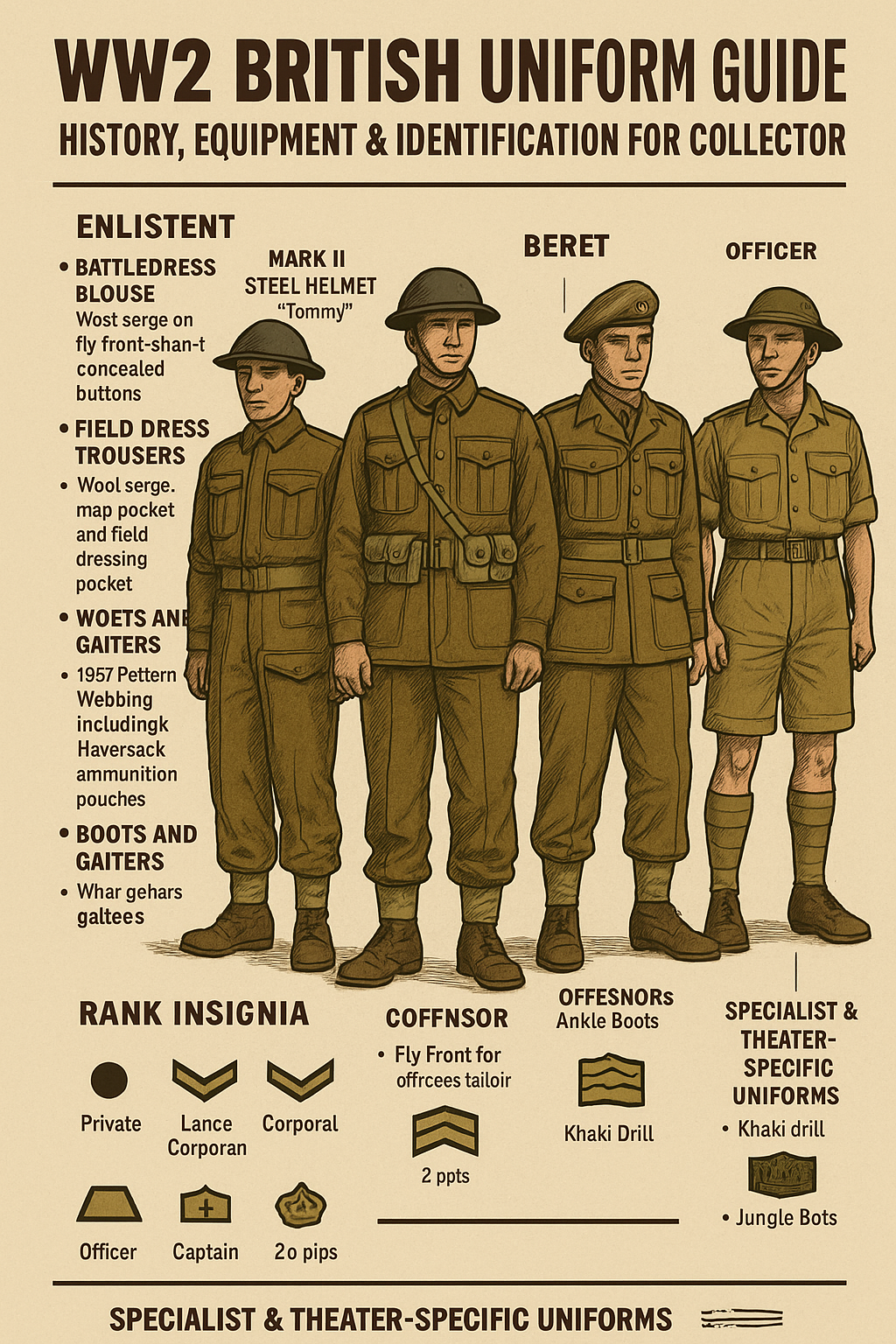
WW2 British Uniform Guide: History, Equipment & Identification for Collectors
Published on Jul 03, 2025
WW2 British Uniform : History & Identification for Collectors
The Second World War was not only a global military conflict but also a defining moment in military fashion and practicality. Among the many armies involved, the British Army stood out with its distinct yet functional uniforms that evolved throughout the war to meet the demands of different theaters and climates.
In this guide, we explore the complete breakdown of the WW2 British uniform, from early war battledress to tropical variations, along with a detailed look at the equipment, rank insignia, and how to identify authentic pieces — ideal for collectors, historians, and reenactors.
1. Background: Why British Uniforms Evolved in WW2
During the early 1930s, British military uniforms were still largely based on styles from World War I. However, by the outbreak of WWII in 1939, it became clear that soldiers needed clothing that supported mobility, camouflage, and multi-environment use.
The result was the Battledress uniform, introduced to replace the outdated Service Dress. As the war progressed and fighting spread from Europe to Africa and Asia, several versions of the uniform emerged.
2. Core Components of the WW2 British Army Uniform
A. Battledress Blouse (Jacket)
- Introduced in 1937 and widely issued in 1940
- Made of wool serge for warmth
- Short waist-length style with a fly front and concealed buttons
- Early models (1937 Pattern) had pleated breast pockets, later dropped in the 1940 Pattern
B. Battledress Trousers
- High-waisted with a map pocket on the leg and a field dressing pocket on the front
- Sturdy wool construction with brace buttons
C. Headgear
- Field Service Cap: Soft side cap, often worn by infantry
- Steel Helmet (Mk II): Standard issue combat helmet, often called the “Tommy helmet”
- Berets: Worn by armored and airborne troops (e.g., maroon for paratroopers, black for tank regiments)
D. Boots and Gaiters
- Ankle boots (Ammo boots) paired with web anklets or puttees
- Later in the war, DMS boots (Direct Moulded Sole) became more common
3. Rank Insignia and Regimental Badges
A. Rank System Overview
WW2 British ranks were displayed on both sleeves or shoulders, depending on uniform and branch.
Enlisted & NCOs:
- Private: No insignia
- Lance Corporal: 1 chevron
- Corporal: 2 chevrons
- Sergeant: 3 chevrons
- Staff Sergeant/Warrant Officer: Crown or Royal Arms above chevrons
Officers:
- 2nd Lieutenant: Single pip
- Lieutenant: Two pips
- Captain: Three pips
- Major: Crown
- Colonel: Crown and two pips
Rank insignia was stitched using khaki or subdued thread for camouflage purposes, especially in combat zones.
4. Specialist and Theater-Specific Uniforms
A. Desert Uniforms (North Africa Campaign)
- Light khaki drill cotton uniforms
- Shorts and long socks in extreme heat
- Pith helmets and bush hats for sun protection
B. Airborne and Commando Units
- Denison Smock: Camouflaged overshirt used by British paratroopers and Commandos
- Jump Boots: Tall lace-up boots with reinforced soles
- Berets and shoulder titles indicating elite status
C. Royal Navy and RAF Uniforms
- Navy blue and black color schemes
- RAF battledress was a variation in blue-grey wool
- Distinct rank insignia on sleeves and shoulders
5. Webbing and Personal Equipment
British soldiers carried essential gear in the 1937 Pattern Webbing system. It included:
- Haversack and water bottle
- Ammunition pouches
- Small pack and entrenching tool
- Bayonet frog
- Gas mask in haversack (especially early war)
Each item had to be well-balanced for long marches and combat readiness.
6. Uniform Variants by Year
YearKey Uniform Features1939 | Mix of WWI Service Dress and new Battledress
1940 | 1940 Pattern BD introduced with fewer pleats
1941–1943 | Tropical and Arctic versions developed
1944–45 | Enhanced camouflage, more boots issued, newer smocks for D-Day
7. Identifying Original vs. Reproduction WW2 British Uniforms
As a collector or reenactor, knowing how to spot authentic gear is essential.
Tips to Identify Originals:
- Look for wartime dates and British War Department broad arrow stamps
- Check for natural aging signs like moth holes or fading
- Study stitching patterns — originals were hand or industrial machine-sewn with care
Websites like Paddelaters.com offer authentic reproductions and guidance for spotting real vs. fake items.
8. Why WW2 British Uniforms Still Matter Today
British WW2 uniforms symbolize:
- Courage and discipline under fire
- Innovation in battlefield uniform design
- Colonial and global reach of British forces
They’re featured in films, documentaries, video games, and military exhibitions. Whether you’re passionate about military history, family ancestry, or collecting artifacts, the British uniform tells a powerful story.
9. How to Build Your Collection or Reenactment Kit
If you’re starting out:
- Begin with a basic battledress set (jacket, trousers, boots, and webbing)
- Add accessories like insignia patches, field gear, and headgear as you go
- Research your unit of interest to be historically accurate
Paddelaters.com offers a curated selection of WW2 British uniforms and gear with attention to authentic detail, perfect for reenactment or display.
Conclusion: More Than Just Uniforms — A Living History
The WW2 British uniform represents more than just what a soldier wore; it tells a story of global conflict, innovation, and resilience. From the rugged beaches of Normandy to the dusty terrain of North Africa, these uniforms helped define one of the world’s most significant historical moments.
Explore the WW2 British uniform collection at Paddelaters.com and step into a piece of history, whether for study, display, or reenactment.
